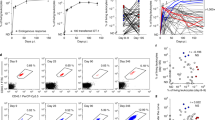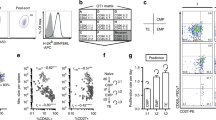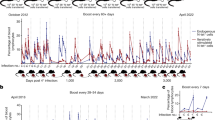Abstract
Immunological memory is the ability of the immune system to respond with enhanced vigour to pathogens that have been encountered in the past. Following infection or immunization, most effector T cells undergo apoptotic cell death, but a small fraction of these cells, proportional to the early antigen load and initial clonal burst size1, persist in the host as a stable pool of memory T cells2,3,4,5,6,7. The existence of immunological memory has been recognized for over 2,000 years, but our understanding of this phenomenon is limited, primarily because memory lymphocytes cannot be unequivocally identified as they lack specific, permanent markers. Here we have developed a transgenic mouse model system whereby memory T cells and their precursors can be irreversibly marked with a reporter gene and thus can be unambiguously identified. Adoptive transfer of marked CD8+ T cells specific for lymphocytic choriomeningitis virus protected naive recipients following viral challenge, demonstrating that we have marked memory T cells. We also show that cytotoxic effector lymphocytes that develop into memory T cells can be identified in the primary response.
This is a preview of subscription content, access via your institution
Access options
Subscribe to this journal
Receive 51 print issues and online access
$199.00 per year
only $3.90 per issue
Buy this article
- Purchase on Springer Link
- Instant access to full article PDF
Prices may be subject to local taxes which are calculated during checkout








Similar content being viewed by others
References
Hou, S., Hyland, L., Ryan, K. W., Portner, A. & Doherty, P. C. Virus-specific CD8+ T-cell memory determined by cloning burst size. Nature 369, 652–654 (1994).
Welsh, R. M. et al. Alpha beta and gamma delta T-cell networks and their roles in natural resistance to viral infections. Immuno. Rev. 159, 79–93 (1997).
Kundig, T. M. et al. On T cell memory: arguments for antigen dependence. Immun. Rev. 150, 63–90 (1996).
Mullbacher, A. & Flynn, K. Aspects of cytotoxic T cell memory. Immun. Rev. 150, 113–127 (1996).
Tough, D. F. & Sprent, J. Lifespan of lymphocytes. Immun. Res. 14, 1–12 (1995).
Swain, S. L. et al. From naive to memory T cells. Immun. Rev. 150, 143–167 (1996).
Doherty, P. C., Topham, D. J. & Tripp, R. A. Establishment and persistence of virus-specific CD4+ and CD8+ T cell memory. Immun. Rev. 150, 23–44 (1996).
Lasko, M. Targeted oncogene activation by site-specific recombination in transgenic mice. Proc. Natl Acad. Sci. USA 89, 6232–6236 (1992).
Cepko, C., Ryder, E. F., Austin, C. P., Walsh, C. & Fekete, D. M. Lineage analysis using retrovirus vectors. Methods Enzymol. 254, 387–419 (1995).
Hanson, R. D., Sclar, G. M., Kanagawa, O. & Ley, T. J. The 5′-flanking region of the human CGL-1/granzyme B gene targets expression of a reporter gene to activated T-lymphocytes in transgenic mice. J. Biol. Chem. 266, 24433–24438 (1991).
Zhumabekov, T., Corbella, P., Tolaini, M. & Kioussis, D. Improved version of a human CD2 minigene based vector for T cell-specific expression in transgenic mice. J. Biol. Chem. 266, 24433–24438 (1991).
Williams, A. F., Barclay, A. N., Clark, S. J., Paterson, D. J. & Willis, A. C. Similarities in sequences and cellular expression between rat CD2 and CD4 antigens. J. Exp. Med. 165, 368–380 (1987).
Wotton, D., Flanagan, B. F. & Owen, M. J. Chromatin configuration of the human CD2 gene locus during T-cell development. Proc. Natl Acad. Sci. USA 86, 4195–4199 (1989).
Nagy, A. et al. Multipurpose gene alterations from a single targeting vector: dissecting the role of N-myc in development. Curr. Biol. 8, 661–664 (1998).
Castan, J., Tenner, R. K., Racz, P., Fleischer, B. & Broker, B. M. Accumulation of CTLA-4 expressing T lymphocytes in the germinal centres of human lymphoid tissues. Immunology 90, 265–271 (1997).
Zheng, B., Han, S., Zhu, Q., Goldsby, R. & Kelsoe, G. Alternative pathways for the selection of antigen-specific peripheral T cells. Nature 384, 263–266 (1996).
Fuller, K. A., Kanagawa, O. & Nahm, M. H. Tcells within germinal centers are specific for the immunizing antigen. J. Immunol. 151, 4505–4512 (1993).
Gulbranson, J. A. & MacLennan, I. Sequential antigen-specific growth of T cells in the T zones and follicles in response to pigeon cytochrome c. Eur. J. Immunol. 26, 1830–1837 (1996).
Ahmed, R., Byrne, J. A. & Oldstone, M. B. Virus specificity of cytotoxic T lymphocytes generated during acute lymphocytic choriomeningitis virus infection: role of the H-2 region in determining cross-reactivity for different lymphocytic choriomeningitis virus strains. J. Virol. 51, 34–41 (1984).
Jamieson, B. D. & Ahmed, R. Tcell memory. Long-term persistence of virus-specific cytotoxic T cells. J. Exp. Med. 169, 1993–2005 (1989).
Selin, L. K., Nahill, S. R. & Welsh, R. M. Cross-reactivities in memory cytotoxic T lymphocyte recognition of heterologous viruses. J. Exp. Med. 179, 1933–1943 (1994).
Zimmerman, C., Brduscha, R. K., Blaser, C., Zinkernagel, R. M. & Pircher, H. Visualization, characterization, and turnover of CD8+ memory T cells in virus-infected hosts. J. Exp. Med. 183, 1367–1375 (1996).
Nahill, S. R. & Welsh, R. M. High frequency of cross-reactive cytotoxic T lymphocytes elicited during the virus-induced polyclonal cytotoxic T lymphocyte response. J. Exp. Med. 177, 317–327 (1993).
Yang, H. Y., Dundon, P. L., Nahill, S. R. & Welsh, R. M. Virus-induced polyclonal cytotoxic T lymphocyte stimulation. J. Immunol. 142, 1710–1718 (1989).
Lau, L. L., Jamieson, B. D., Somasundaram, T. & Ahmed, R. Cytotoxic T-cell memory without antigen. Nature 369, 648–652 (1994).
Ahmed, R. & Gray, D. Immunological memory and protective immunity: understanding their relation. Science 272, 54–60 (1996).
Zinkernagel, R. M. et al. On immunological memory. Annu. Rev. Immunol. 14, 333–367 (1996).
Murali, K. K. et al. Counting antigen-specific CD8 T cells: a reevaluation of bystander activation during viral infection. Immunity 8, 177–187 (1998).
Butz, E. A. & Bevan, M. J. Massive expansion of antigen-specific CD8+ T cells during an acute virus infection. Immunity 8, 167–175 (1998).
Ahmed, R., Salmi, A., Butler, L. D., Chiller, J. M. & Oldstone, M. B. A. Selection of genetic variants of lymphocytic choriomeningitis virus in spleens of persistently infected mice: role in suppression of cytotoxic T lymphocyte response and viral persistence. J. Exp. Med. 60, 521–540 (1984).
Acknowledgements
We thank C. Roman, I. Stancovski, S. Cherry, K. Alexandroplous, M. Scott, G.Kelsoe, R. Welsh, L. Selin, R. Ahmed and members of the Baltimore laboratory for useful discussions. We also thank T. Ley for p687 plasmid; R. Welsh, R. Ahmed and J. Carlos de la Torre for LCM viral stocks; D. Kioussis for the VahCD2 transgenic construct; M. Brasch for pBS185 and pBS302 plasmids; and A.Nagy for the hCMV-Cre transgenic mice. J.J. Thanks H. Rayburn and W. Sha for teaching him pronuclear injection and transgenesis, and M. Scott for help with adoptive transfers. J.J. was a recipient of a postdoctoral fellowship from the Helen Hay Whitney foundation and is currently a special fellow of the Leukemia Society of America.
Author information
Authors and Affiliations
Corresponding author
Rights and permissions
About this article
Cite this article
Jacob, J., Baltimore, D. Modelling T-cell memory by genetic marking of memory T cells in vivo. Nature 399, 593–597 (1999). https://doi.org/10.1038/21208
Received:
Accepted:
Issue Date:
DOI: https://doi.org/10.1038/21208
This article is cited by
-
The transcriptional cofactor Tle3 reciprocally controls effector and central memory CD8+ T cell fates
Nature Immunology (2024)
-
Tissue-resident memory T cells in the urogenital tract
Nature Reviews Nephrology (2022)
-
A novel conditional NPM-ALK-driven model of CD30+ T-cell lymphoma mediated by a translational stop cassette
Oncogene (2020)
-
Clonal expansion of innate and adaptive lymphocytes
Nature Reviews Immunology (2020)
-
Effector CD8 T cells dedifferentiate into long-lived memory cells
Nature (2017)
Comments
By submitting a comment you agree to abide by our Terms and Community Guidelines. If you find something abusive or that does not comply with our terms or guidelines please flag it as inappropriate.



